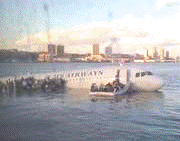Bird Strike Committee Proceedings

Bird Strike Committee-USA/Canada Joint Annual Meeting: 10th (2008)
Date of this Version
8-2008
Document Type
Article
Abstract
Florida is one of twelve or fewer states that regulate storm water quality on a statewide basis. The most commonly used design for water quality management is a vegetated, permanently wet pond that is presumed to meet water quality standards. Also, typical designs fully convey extreme rainfall events to the same wet ponds, which must then be sized for flood attenuation. These design features can and do attract birds and other wildlife that can be hazardous to flight. The Florida Department of Transportation and the Federal Aviation Administration fund the Florida Statewide Airport Stormwater Study to develop data and approaches to meet water management requirements while eliminating or reducing design features that attract wildlife. A stakeholder group composed of the Florida Department of Environmental Protection and the Water Management Districts, along with FAA and FDOT provide guidance to the consultant and university team doing the study. Initial results, published and accepted, characterize the runoff from airport airside pavement. This includes water quality and quantity, with 5 minute rainfall data. These data indicate that a majority of airside pavement can use overland flow, without ponds, for airside water management. Copper is generally the controlling pollutant. These study results are now in the rule-making stage. Computational fluid dynamics suggests that a linear, steep sided pond without vegetated shelves may provide water management functions for those cases where overland flow will not work. The program results to date and current status are summarized in this paper, including a discussion on implementing the results to design, permitting and construction of airport pavements.


Comments
Abstract of paper presented at Bird Strike Committee USA/Canada Meeting, Lake Mary and Sanford, Florida, August 18–21, 2008.